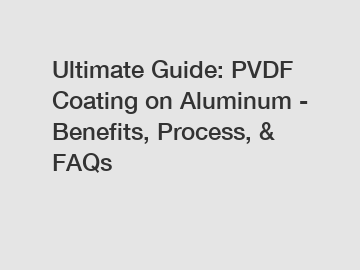Ultimate Guide: PVDF Coating on Aluminum - Benefits, Process, & FAQs
Aluminum is a versatile metal that is widely used in various industries due to its lightweight, durable, and corrosion-resistant properties. However, in order to enhance its performance and prolong its lifespan, it is often coated with different types of coatings. One popular choice is PVDF (Polyvinylidene fluoride) coating, which offers a range of benefits and is widely regarded as one of the best coating options for aluminum surfaces.
In this comprehensive guide, we will explore the benefits of PVDF coating on aluminum, the process of applying the coating, and answer some frequently asked questions about this high-performance coating.
Benefits of PVDF Coating on Aluminum:

1. Superior Durability: PVDF coating is known for its exceptional durability and resistance to harsh environmental conditions. It provides excellent protection against UV radiation, moisture, chemicals, and abrasion, making it ideal for outdoor applications.
2. Enhanced Aesthetics: PVDF coating is available in a wide range of colors and finishes, allowing for endless design possibilities. It provides a smooth, uniform finish that retains its color and gloss for years, making it a popular choice for architectural applications.
3. Low Maintenance: PVDF-coated aluminum requires minimal maintenance and cleaning, thanks to its self-cleaning properties and resistance to dirt and grime. This makes it ideal for high-traffic areas where frequent cleaning may not be practical.
4. Thermal Stability: PVDF coating has excellent thermal stability, making it suitable for use in extreme temperature environments. It can withstand temperature fluctuations without cracking, peeling, or fading, ensuring long-lasting performance.
5. Environmental Friendly: PVDF coating is a low VOC (volatile organic compound) option, making it an environmentally friendly choice for sustainable building projects. It is also recyclable and can contribute to LEED certification.
Process of Applying PVDF Coating on Aluminum:
The process of applying PVDF coating on aluminum involves several steps to ensure a smooth, uniform finish and maximum adhesion to the substrate. Here is an overview of the process:
1. Surface Preparation: The aluminum surface is cleaned and pretreated to remove any contaminants, such as oil, grease, and dirt, that may interfere with the adhesion of the coating.
2. Priming: A primer is applied to the aluminum surface to promote adhesion and corrosion resistance. The primer also helps to smooth out any imperfections on the surface and create a strong bond with the topcoat.
3. Coating Application: The PVDF coating is applied to the primed aluminum surface using a spray gun or a coil coating process. The coating is typically applied in multiple thin layers to achieve the desired thickness and finish.
4. Curing: The coated aluminum is then cured at high temperatures to crosslink the polymer molecules and create a durable, protective finish. This step is crucial to ensure the coating's performance and longevity.
5. Quality Control: The coated aluminum undergoes rigorous quality control measures to check for adhesion, thickness, and appearance. Any defects or inconsistencies are addressed before the final product is approved for use.
Frequently Asked Questions about PVDF Coating on Aluminum:
Q: Is PVDF coating suitable for all types of aluminum surfaces?
A: Yes, PVDF coating is compatible with a wide range of aluminum alloys and surface finishes, including extrusions, sheets, and panels. It can be applied to both new and existing aluminum surfaces.
Q: How long does PVDF coating last on aluminum?
A: PVDF coating can last up to 30 years or more, depending on the quality of the coating, environmental conditions, and maintenance. Regular cleaning and maintenance can help extend the lifespan of the coating.
Q: Can PVDF-coated aluminum be repaired or recoated?
A: Yes, damaged or faded PVDF-coated aluminum can be repaired or recoated to restore its appearance and performance. It is recommended to consult a professional for proper repair and recoating procedures.
In conclusion, PVDF coating on aluminum offers a range of benefits, including superior durability, enhanced aesthetics, low maintenance, thermal stability, and environmental friendliness. The process of applying PVDF coating involves surface preparation, priming, coating application, curing, and quality control measures to ensure a high-quality finish. By understanding the benefits, process, and FAQs of PVDF coating, you can make an informed decision when choosing this high-performance coating for your aluminum surfaces.
The company is the world’s best coil coating aluminum, aluminum roof coil, custom pupa coated aluminium coil factory supplier. We are your one-stop shop for all needs. Our staff are highly-specialized and will help you find the product you need.
106
0
0


Comments
All Comments (0)